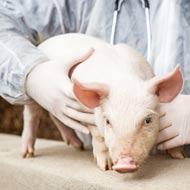
Pestivirus related to virus that causes swine fever
Researchers in Austria have identified a new pestivirus that attacks the nervous system of pigs.
The pathogen was discovered in so-called “shaking pigs” and is related to both Australian Bungowannah virus and, more distantly, classical swine fever.
Because of the symptoms it causes, researchers have named the disease LINDA virus (Lateral shaking Inducing NeuroDegenerative Agent). However, it is not yet known how widespread the disease is, or how much of a danger it poses to pig breeding.
The findings have been published in the journal, Emerging Infectious Diseases.
“We are currently developing a serological test to learn more about the prevalence of the Linda virus in Austria, i.e. about the number of piglets it infects,” explains Benjamin Lamp of the Institute of Virology.
“The test will be important because analysis of the virus has shown that it is distantly related to the virus that causes classical swine fever. We cannot exclude the possibility that it might interfere with the official tests for swine fever.”
So-called “shaking piglets” have symptoms that resemble those of classical swine fever, with extensive damage to the brain and the spinal cord. The disease is believed to be caused be an atypical porcine pestivirus (APPV), which was only recently discovered.
In 2015, an Austrian pig breeder observed a number of newborn “shaking piglets” on his farm. As such, experts at Vetmeduni Vienna checked whether the animals were infected with the recently described APPV.
Despite comprehensive testing, neither APPV nor another pathogen known to cause the disease could be found. However, the symptoms and the results suggested that a pestivirus was somehow involved, so the team designed a new type of diagnostic test that ultimately led to the discovery of the new pestivirus.
“The new PCR assay our team developed recognised all known pestiviruses and so enabled us to detect a virus that was previously unknown,” explains Lamp.
“Pestiviruses are known to infect foetuses of pigs, sheep and cattle, often targeting the central nervous system. But pestiviral infections are widespread only in hoofed animals and so not at all dangerous to humans."



 BSAVA is to partner with BVA Live (11-12 June 2026) to champion clinical research.
BSAVA is to partner with BVA Live (11-12 June 2026) to champion clinical research.